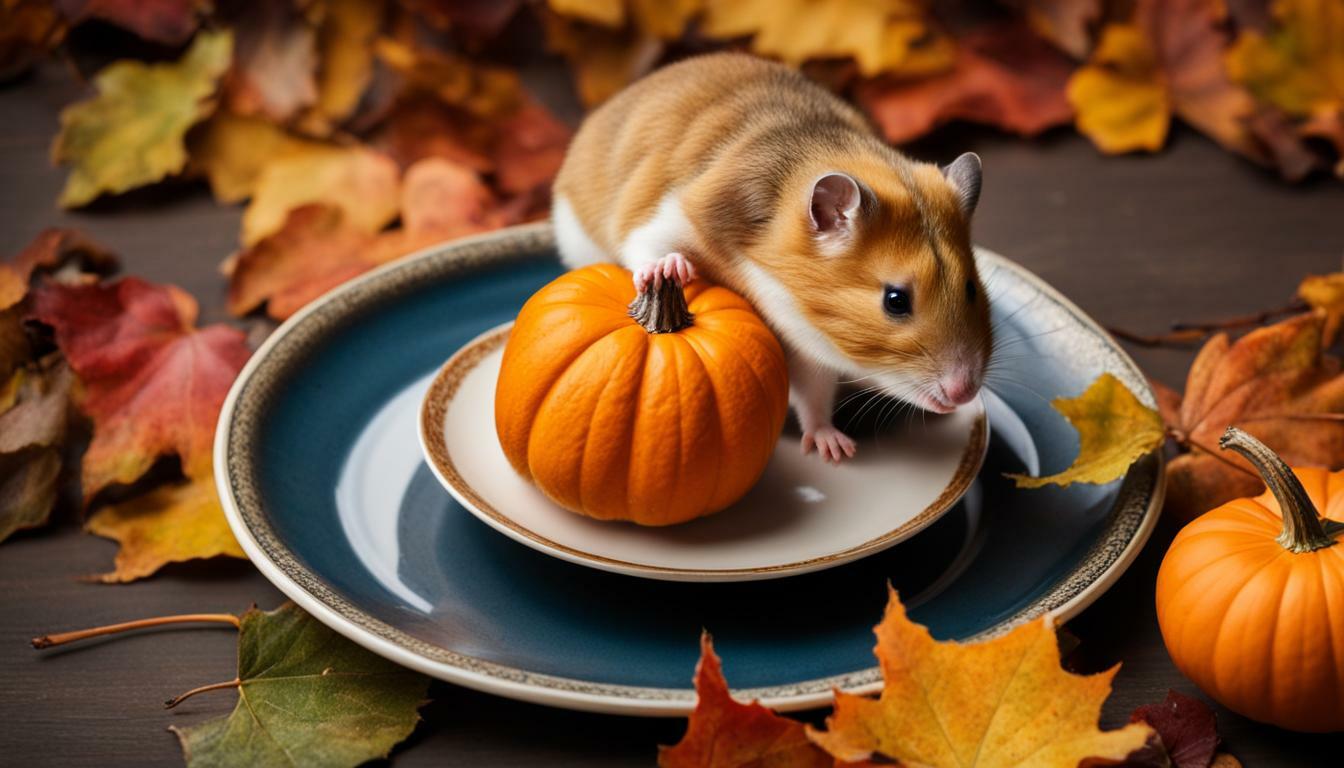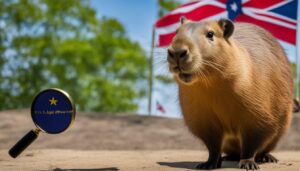If you’re wondering whether your furry friend can indulge in a little pumpkin treat, the answer is yes! Hamsters can safely eat pumpkin, both the flesh and the seeds. Not only is it safe for them, but pumpkin also offers some health benefits for these small rodents.
Pumpkin is a nutritious option for hamsters as it contains essential nutrients like protein, fiber, calcium, phosphorus, and potassium. These nutrients contribute to their overall well-being and can support a healthy diet.
When it comes to serving pumpkin to your hamster, you have a choice between raw or cooked. While both options are safe, raw pumpkin is generally preferred as it retains more of its nutritional value. If you decide to cook the pumpkin, make sure to avoid using any seasonings or additives that may be harmful to your hamster.
It’s important to note that while pumpkin is a healthy treat for hamsters, it should be fed in moderation. Too much pumpkin can lead to an imbalance in their diet due to its high water content and excess sugar. In addition, it’s crucial to monitor your hamster’s digestive health. Diarrhea in hamsters should be treated as an emergency, as it can lead to electrolyte imbalances. Adjusting their pumpkin consumption may be necessary in such cases.
When preparing pumpkin for your hamster, make sure to wash it thoroughly to remove any dirt or bacteria. Serve it at room temperature to make it more enticing and easier for your furry friend to eat. It’s also important to remove any uneaten pumpkin after 4-6 hours to prevent spoilage and potential health risks.
While pumpkins can be left in the cage for your hamster to enjoy, remember to remove them before they go bad. Hamsters have a tendency to hoard food, and spoiled pumpkin can cause health issues if consumed.
As always, it’s best to consult a veterinarian for more specific advice about your hamster’s dietary welfare. They can provide personalized recommendations and ensure your furry friend stays healthy and happy.
Key Takeaways:
- Pumpkin is safe for hamsters to eat, including both the flesh and the seeds.
- Pumpkin offers various health benefits for hamsters due to its nutrient content.
- Raw pumpkin is generally preferred, but cooked pumpkin can also be served.
- Feed pumpkin to your hamster in moderation due to its high water content and excess sugar.
- Monitor your hamster’s digestive health and address any diarrhea as an emergency.
The Benefits of Pumpkin for Hamsters
Pumpkin not only adds a festive touch to your hamster’s diet, but it also offers several health benefits. This bright orange vegetable is packed with essential nutrients that can contribute to your little furry friend’s overall well-being.
One of the key benefits of pumpkin for hamsters is its high fiber content. Fiber is crucial for proper digestion and can help prevent constipation. It also promotes a healthy gut microbiome, which plays a vital role in your hamster’s immune system.
Pumpkin is also a good source of vitamins and minerals. It contains vitamin A, which supports vision and immune function, and vitamin C, which helps boost the immune system. Additionally, pumpkin provides important minerals like calcium, phosphorus, and potassium, which are important for bone health and overall bodily functions.
When feeding pumpkin to your hamster, it’s important to do so in moderation. While the health benefits are significant, pumpkin has a high water content, so excessive consumption can lead to diarrhea. It’s crucial to monitor your hamster’s stool and adjust the amount of pumpkin accordingly. If your hamster experiences diarrhea, it should be treated as an emergency, as it can result in electrolyte imbalance.
| Nutrient | Amount per 100g of Pumpkin |
|---|---|
| Protein | 1g |
| Fiber | 0.5g |
| Calcium | 19mg |
| Phosphorus | 12mg |
| Potassium | 340mg |
Summary:
- Pumpkin is safe and healthy for hamsters to consume.
- It is rich in fiber, vitamins, and minerals.
- Feeding pumpkin in moderation is important due to its high water content.
- Diarrhea in hamsters should be treated as an emergency.
- Always consult a veterinarian for more specific advice regarding your hamster’s diet.
Feeding Pumpkin to Your Hamster
When it comes to feeding pumpkin to your hamster, there are a few important considerations to keep in mind. Pumpkin can be a tasty and nutritious treat for your furry friend, but it’s essential to provide it in the right way to ensure their safety and well-being. Here are some guidelines to help you navigate the world of feeding pumpkin to your hamster.
1. Preparation:
Start by selecting a fresh and ripe pumpkin. Wash it thoroughly to remove any dirt or pesticides. You’ll want to remove the stem, skin, and seeds before offering it to your hamster. Cut the pumpkin into small, bite-sized pieces that are easy for them to chew and digest.
2. Portion Sizes:
Hamsters have tiny tummies, so it’s crucial to provide pumpkin in moderation. A small piece, about the size of their paw, once or twice a week is sufficient. Monitor their reaction and digestion to ensure they tolerate it well. If you notice any adverse effects, such as diarrhea or stomach upset, discontinue feeding pumpkin and consult a veterinarian.
3. Serving Temperature and Storage:
Pumpkin should be served at room temperature. Avoid serving it straight from the refrigerator, as the cold temperature can be uncomfortable for your hamster. If there are any leftovers, remove them from the cage after 4-6 hours to prevent spoiling. Hamsters have a habit of hoarding food, so be careful not to leave uneaten pumpkin inside their nest.
4. Nutritional Benefits:
| Nutrient | Amount |
|---|---|
| Protein | 1.2 g |
| Fiber | 0.6 g |
| Calcium | 3 mg |
| Phosphorus | 11 mg |
| Potassium | 230 mg |
Pumpkin contains essential nutrients like protein, fiber, calcium, phosphorus, and potassium, which can contribute to your hamster’s overall health. However, remember that it should be offered as a treat and not a staple part of their diet. A well-balanced hamster diet should consist mostly of commercial pellet or seed mixes, along with occasional fresh fruits and vegetables.
As always, it’s important to consult a veterinarian for more specific advice regarding your hamster’s dietary needs. They can provide personalized recommendations based on your furry friend’s age, breed, and overall health. By following these guidelines, you can safely incorporate pumpkin into your hamster’s diet and provide them with a delicious and nutritious treat.
Raw or Cooked Pumpkin?
You may be wondering whether it’s best to serve your hamster raw or cooked pumpkin – let’s find out! Hamsters can safely eat both raw and cooked pumpkin, but raw pumpkin is generally preferred for their digestive system. Raw pumpkin retains more of its natural nutrients and fiber, making it more beneficial for your hamster’s health. However, if you choose to cook the pumpkin, it should be baked or steamed without any added seasoning or oils.
Raw pumpkin offers more crunch and texture, which can help keep your hamster’s teeth healthy by promoting natural wear. It also provides additional hydration due to its high water content, keeping your hamster well-hydrated. Cooked pumpkin, on the other hand, can be easier for some hamsters to digest, especially if they have sensitive stomachs.
When serving raw pumpkin, make sure to wash it thoroughly to remove any dirt or pesticides. Cut the pumpkin into small, bite-sized pieces that are easy for your hamster to handle. If you opt for cooked pumpkin, allow it to cool down before serving it to your furry friend. Remember to remove any seeds, as they can be a choking hazard for hamsters.
| Raw Pumpkin | Cooked Pumpkin |
|---|---|
| Retains natural nutrients and fiber | Easier to digest for some hamsters |
| Promotes healthy teeth | Less hydrating compared to raw pumpkin |
| High water content for hydration | Requires baking or steaming without seasoning or oils |
Remember to introduce pumpkin gradually into your hamster’s diet and monitor their response. Some hamsters may have sensitive stomachs and may experience digestive issues if given too much pumpkin too quickly. Always feed pumpkin in moderation, as excessive consumption can lead to an imbalance in their diet and potential health issues.
As with any dietary changes, it’s essential to consult a veterinarian for specific advice tailored to your hamster’s needs. They can provide guidance on portion sizes, frequency, and any other concerns you may have about incorporating pumpkin into your hamster’s diet. With proper care and moderation, pumpkin can be a healthy and enjoyable treat for your furry friend!
Pumpkin Seeds for Hamsters
In addition to the pumpkin flesh, you may also be curious about whether your hamster can munch on pumpkin seeds. Good news! Pumpkin seeds can be a nutritious and tasty treat for your furry little friend. These seeds provide a range of essential nutrients that can contribute to your hamster’s overall well-being.
Pumpkin seeds are packed with protein, fiber, and healthy fats, making them a great addition to your hamster’s diet. They also contain important minerals like calcium, phosphorus, and potassium, which are necessary for maintaining strong bones and a healthy immune system. The seeds can also help with your hamster’s dental health, as the act of gnawing on them can help keep their teeth in good condition.
When feeding pumpkin seeds to your hamster, it’s important to do so in moderation. While they offer numerous benefits, they are high in fat, so excessive consumption can lead to weight gain or other health issues. As a general guideline, you can offer your hamster a small portion of pumpkin seeds a few times a week as a special treat. It’s always important to monitor your hamster’s overall diet and consult with a veterinarian if you have any concerns.
Table: Nutritional Content of Pumpkin Seeds
| Nutrient | Amount per 100g |
|---|---|
| Protein | 19g |
| Fiber | 6g |
| Fat | 49g |
| Calcium | 46mg |
| Phosphorus | 1233mg |
| Potassium | 809mg |
Remember, it’s crucial to provide a diverse and balanced diet for your hamster, incorporating a variety of fresh fruits, vegetables, and high-quality hamster food. Pumpkin seeds should only be offered as an occasional treat, alongside their regular diet. By offering pumpkin seeds in moderation, you can give your hamster a delicious and nutritious snack that they will love!
Pumpkin Moderation and Potential Risks
While pumpkin can be a healthy addition to your hamster’s diet, it’s crucial to exercise moderation to ensure their well-being. Pumpkin contains high water content, which can contribute to diarrhea if consumed in excess. Additionally, the natural sugars present in pumpkin can lead to health issues if your hamster consumes too much.
When feeding pumpkin to your hamster, it’s important to offer it as a treat rather than a staple food. Too much pumpkin can upset the balance of their diet and potentially lead to digestive problems. It’s recommended to provide small, bite-sized portions of pumpkin no more than a few times per week.
To help prevent diarrhea, consider cooking the pumpkin before serving it to your hamster. Raw pumpkin can be more difficult for their digestive system to break down, while cooked pumpkin is easier to digest. However, if your hamster prefers raw pumpkin and doesn’t experience any digestive issues, it should be safe to continue offering it this way.
| Pumpkin Moderation Tips | Potential Risks |
|---|---|
| Feed in moderation: Offer small amounts of pumpkin as a treat a few times per week. | Diarrhea: Excessive pumpkin consumption can lead to diarrhea, so monitor your hamster’s stools and adjust accordingly. |
| Cooked or raw: Cooked pumpkin is generally easier to digest, but monitor your hamster’s reaction and feed accordingly. | Excess sugar: Too much pumpkin can contribute to weight gain and other health issues due to its natural sugar content. |
| Remove uneaten pumpkin: Discard any uneaten pumpkin after 4-6 hours to prevent spoilage and bacterial growth. | Electrolyte imbalance: Diarrhea can cause electrolyte imbalance, which can be dangerous for your hamster. Consult a veterinarian if diarrhea persists. |
Handling Diarrhea in Hamsters
If your hamster experiences diarrhea after eating pumpkin or any other food, it is important to address it promptly. Diarrhea can lead to dehydration and electrolyte imbalance, which can be life-threatening for hamsters. Make sure to provide your hamster with water and consult a veterinarian for guidance. Adjust their diet accordingly, removing any food that may be contributing to the diarrhea, including pumpkin.
In conclusion, while pumpkin can offer health benefits to your hamster, it should be fed in moderation. Pay close attention to your hamster’s reaction and adjust their diet as needed. Always consult a veterinarian for more specific advice regarding your hamster’s dietary welfare.
Handling Diarrhea in Hamsters
Diarrhea is a serious concern for hamsters, and understanding how to manage it is crucial when incorporating pumpkin into their diet. While pumpkin is generally safe for hamsters, excessive consumption or sudden dietary changes can lead to digestive upset and diarrhea. It’s important to monitor your hamster’s stool consistency and take immediate action if you notice any changes.
One possible cause of diarrhea in hamsters is an imbalance in their electrolytes, which can occur due to dehydration from excessive fluid loss. This is especially important to note because pumpkin has a high water content. If your hamster experiences diarrhea, it is crucial to provide prompt treatment to avoid electrolyte imbalances.
When diarrhea occurs, it is recommended to temporarily remove pumpkin from your hamster’s diet until their stool returns to normal. Additionally, make sure your hamster has access to clean, fresh water at all times to prevent dehydration. If the diarrhea persists or your hamster shows signs of dehydration, such as lethargy or loss of appetite, contact a veterinarian immediately for further guidance.
| Signs of Dehydration in Hamsters: |
|---|
| – Lethargy and lack of energy |
| – Sunken or dry eyes |
| – Loss of appetite |
| – Dry or sticky gums |
| – Reduced skin elasticity |
In conclusion, while pumpkin can be a healthy addition to your hamster’s diet, it is important to introduce it gradually and in moderation. Keep a close eye on your hamster’s stool and overall well-being, and consult with a veterinarian if you have any concerns or notice persistent diarrhea. By following these guidelines and providing proper care, you can ensure that your hamster remains healthy and happy.
Preparing Pumpkin for Your Hamster
Before serving pumpkin to your hamster, it’s important to follow a few simple steps to ensure its safety and freshness. Hamsters can enjoy both the flesh and seeds of pumpkin, but it’s crucial to prepare and serve it properly to avoid any potential health risks.
Cleaning and Cutting:
Start by thoroughly washing the pumpkin to remove any dirt or pesticides. This is essential, as hamsters have sensitive digestive systems. Once cleaned, you can remove the stem and cut the pumpkin into small, manageable pieces. Avoid using any utensils or surfaces that may be contaminated with harmful substances.
Serving and Storage:
Hamsters prefer their food to be served at room temperature, so allow the pumpkin pieces to cool down before offering them to your furry friend. It’s important to note that hamsters have small stomachs and can overeat, so provide only a small portion at a time. Remove any uneaten pumpkin after 4-6 hours to prevent spoilage. Remember, hamsters have a habit of hoarding food, so it’s best to remove the pumpkin from their cage before it goes bad.
Consult a Veterinarian:
While pumpkin is generally safe for hamsters, it’s always a good idea to consult a veterinarian for specific advice regarding your hamster’s diet. They can provide guidance on portion sizes, frequency of feeding, and any potential concerns based on your hamster’s individual health needs. Your veterinarian will have the expertise to ensure your hamster’s dietary welfare.
| Pumpkin Nutritional Content: | Per 100g |
|---|---|
| Protein: | 1.0g |
| Fiber: | 0.5g |
| Calcium: | 4.0mg |
| Phosphorus: | 8.0mg |
| Potassium: | 230mg |
Remember, pumpkin should be fed in moderation due to its high water content, and excess sugar can lead to health issues for hamsters. Always prioritize their well-being and consult a veterinarian for personalized advice.
Conclusion
In conclusion, pumpkin can be a safe and healthy addition to your hamster’s diet. Hamsters can eat both the flesh and the seeds of pumpkin, making it an enjoyable treat for them. Pumpkin is considered safe for hamsters and offers some health benefits due to its nutrient content. It is rich in protein, fiber, calcium, phosphorus, and potassium, which can contribute to their overall well-being.
Feeding pumpkin to your hamster can be done in both raw and cooked forms, although raw pumpkin is preferred for their digestive system. It is important to note that pumpkin should be fed in moderation, as it has a high water content and excess sugar can lead to health issues for hamsters. It’s always best to consult with a veterinarian for personalized guidance on your hamster’s dietary needs.
When preparing pumpkin for your hamster, make sure to wash it thoroughly to remove any dirt or pesticides. Serving it at room temperature is ideal, as cold pumpkin may cause discomfort for your furry friend. Additionally, uneaten pumpkin should be discarded after 4-6 hours to prevent spoilage. Keep in mind that hamsters have a tendency to hoard food, so any pumpkin left in their cage should be removed before it goes bad.
To ensure the best care for your hamster, always consult a veterinarian for more information about their dietary welfare. They can provide you with specific guidance and recommendations based on your hamster’s individual needs. So go ahead and treat your hamster to some pumpkin, but remember to do so in moderation and with the guidance of a veterinary professional.
FAQ
Can hamsters eat pumpkin?
Yes, hamsters can eat pumpkin. Both the flesh and the seeds are safe for them.
What are the benefits of pumpkin for hamsters?
Pumpkin is a nutritious food for hamsters, containing protein, fiber, calcium, phosphorus, and potassium. It can contribute to their overall well-being.
How should I feed pumpkin to my hamster?
Pumpkin should be washed thoroughly and served at room temperature. It is important to feed pumpkin in moderation and discard any uneaten pumpkin after 4-6 hours.
Can hamsters eat raw or cooked pumpkin?
Hamsters can eat both raw and cooked pumpkin, but raw pumpkin is preferred for their digestive system.
Can hamsters eat pumpkin seeds?
Yes, hamsters can eat pumpkin seeds. They provide nutritional value, but it’s important to be cautious of the portion size and any potential risks.
Should I be careful with the amount of pumpkin I feed my hamster?
Yes, it is important to feed pumpkin to your hamster in moderation due to its high water content and the potential risks of excess sugar. Consult your veterinarian for specific guidelines.
How should I handle diarrhea in my hamster related to pumpkin consumption?
Diarrhea in hamsters should be treated as an emergency, as they can quickly lose electrolytes. Adjust the amount of pumpkin in their diet accordingly and seek veterinary advice.
How should I prepare pumpkin for my hamster?
Thoroughly wash the pumpkin, cut it into appropriate-sized pieces, and serve it at room temperature. Remove any uneaten pumpkin before it goes bad. Properly store any leftover pumpkin.
Can you summarize the key points about feeding pumpkin to hamsters?
Hamsters can safely eat pumpkin and its seeds. Pumpkin is nutritionally beneficial but should be fed in moderation. Diarrhea should be treated as an emergency, and proper preparation and storage are important. Consult a veterinarian for more specific advice.




